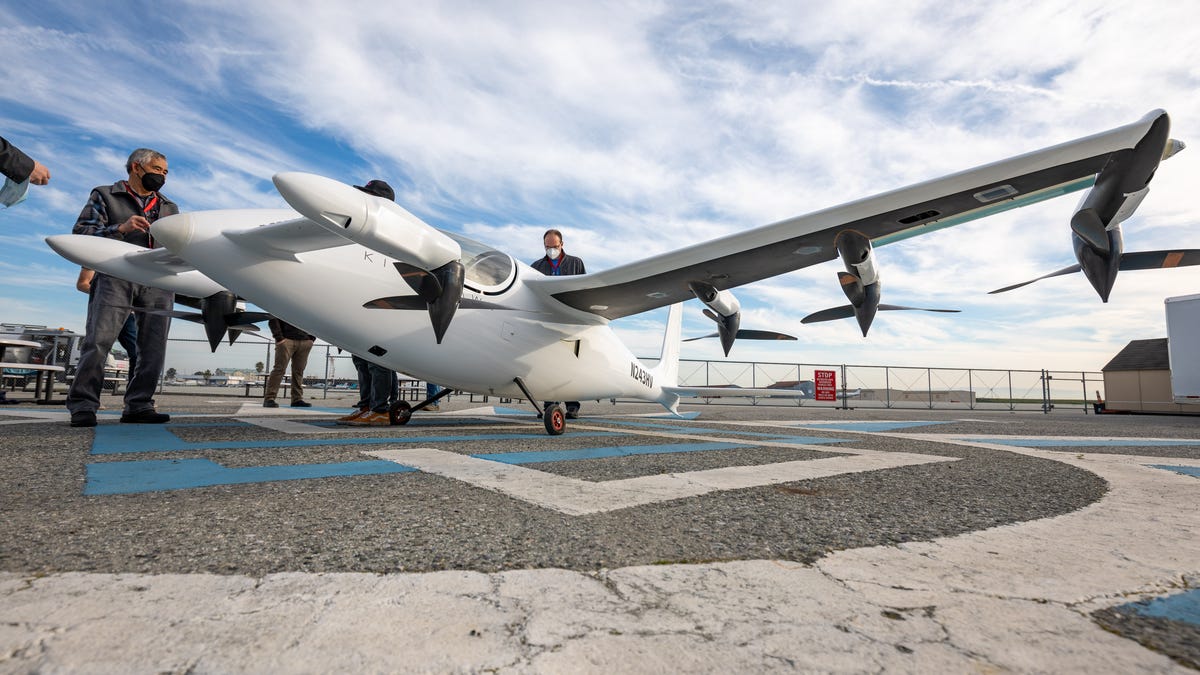These new air taxis could whisk you into the sky without a pilot
New aircraft designs could power air taxis that later this decade will pop you above the traffic for fast, though probably pricey, journeys around town.

The Kittyhawk Heaviside 2 is an air taxi designed to transport a single passenger 60 to 100 miles in less than an hour.
At the Transformative Vertical Flight 2022 conference last week, startup Kittyhawk showed off the latest prototype of its Heaviside 2, an aircraft it believes can serve as the workhorse for a fleet of self-flying taxis that ultimately will be affordable to many.
The Heaviside 2 is a single-passenger EVTOL -- electric vertical takeoff and landing -- machine designed to transport a passenger 60 to 100 miles in less than an hour. Its unusual design employs eight propellers: two on smaller forward wings and six on a pair of larger, centrally mounted forward-swept wings. Propellers can pivot downward from the trailing edge of the wings for takeoff and landing.
The goal is to develop an aircraft with a "cost per mile on the order of an existing Uber ride," said Chuck Taylor, director of flight operations at Kittyhawk, which was funded by Google co-founder Larry Page.
The Heaviside 2, as well as other aircraft on display at the conference, incorporates the latest iteration of VTOL technology, which allows aircraft to take off and land without the long runways conventional fixed-wing planes require. Among the improvements are cleaner, quieter electric designs and autonomous navigation technology that could reduce or even eliminate the need for pilots.
The new designs, which come from both startups and established aerospace giants, could spur a renaissance in aircraft design and use if aircraft makers can persuade regulators to sign off on them. The companies also will need to convince the public, which could be skeptical about climbing into a vehicle with no human pilot and worried about noise and antsy about rooftops and strip malls becoming miniature airports.
Ultimately, people will come around, Taylor believes, as they did to conventional cars and aircraft that radically transformed transportation in earlier decades.
The concept for VTOL aircraft has been around for centuries. More than 500 years ago, Leonardo da Vinci sketched a design for one that included an "aerial screw." One of the surprise demonstrations at the conference was a quadcopter drone based on the Italian genius' design.
VTOLs didn't come into use until practical helicopters were designed. A few airplanes tried to employ the concept, including the Boeing V-22 Osprey tilt-rotor aircraft, the Harrier "Jump Jet" and the recent Lockheed Martin F-35B Lightning II fighter jet. But the complexities of piloting those jest and their complex designs limited success.
Modern drones, however, have helped breathe new life into the idea. Operated by hobbyists and professionals, drones are prompting airspace regulators to rethink air traffic control. Executives at a host of startups like Archer Aviation and NFT, as well as Kittyhawk, believe now is the time for new ideas.
A host of new designs are emerging. Among others at the show:
- Elroy Air's Chaparral. You won't be traveling in this VTOL that debuted at the show, but whatever you ordered online might. This VTOL -- a fuel-powered hybrid electric model -- is designed to carry payloads up to 300 pounds for distances up to 300 miles, speeding up logistics to enable same-day shipping anywhere. The aircraft are unmanned but operated by remote pilots, according to Chief Executive David Merrill.
- Transcend Air's Vy 400. It's got tilting wings that point four propellers upward for takeoff and landing. A prototype at the show used electric motors powered by lithium ion batteries, but the full-scale model planned for 2024 operations will use conventional jet fuel to shuttle people from city to city at an altitude of 18,000 feet to 20,000 feet, said test pilot Peter Vollheim. The company has 500 orders so far, he said.
- Jaunt Air Mobility's Jaunt Journey. The EVTOL combines a fixed-winged airplane's wings with a helicopter's rotors that can rotate slowly once the aircraft is underway. It's designed to carry four passengers 80 to 120 miles at a top speed of 175 mph starting in 2026, according to senior engineer Jeff Lewis.
- Airbus' Vahana. The aerospace giant's eight-propeller EVTOL test vehicle has since been superseded by its four-passenger CityAirbus NextGen project, which has a range of 50 miles and a top speed of about 80 mph.
- Tier 1 Engineering's electric helicopter. To ease regulatory approval, the southern California aerospace company modified an approved Robinson Helicopter R44 Raven II design, swapping out its conventional powertrain with a large battery and electric motor that's 20% quieter. It can fly for 40 minutes, though the company hopes to extend that to an hour for tours, charter flights and training, said company founder Glen Dromgoole.

